
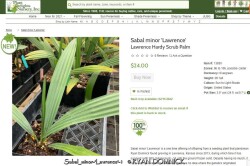

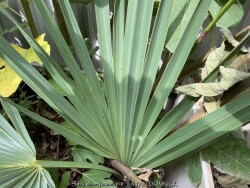
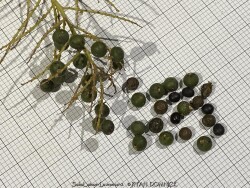
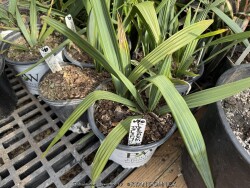


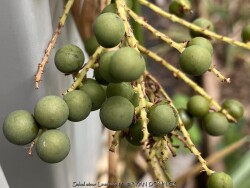
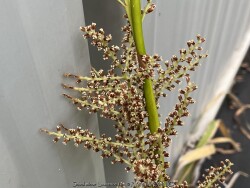
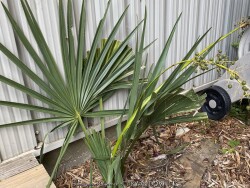
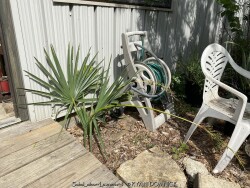
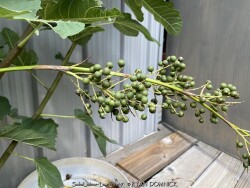
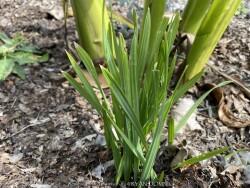
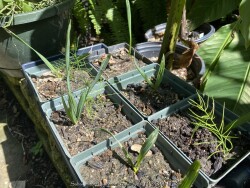
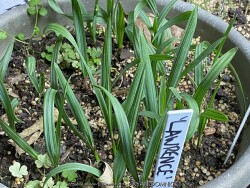
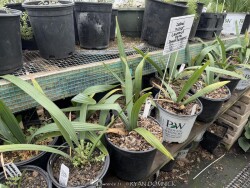
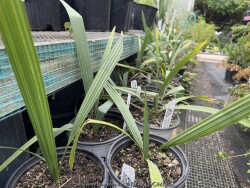
Plant Min Zone: 6a
Plant Max Zone: 10b
Sunlight: Full Sun, Part Sun
Water / Rainfall: Average, High, Very High
Soil Quality: Average, Rich
Bloom Season: Summer
Flower Color: Insignificant
Berry / Fruit Color: Black
Spring Foliage Color: Green
Summer Foliage Color: Green
Fall Foliage Color: Green
Evergreen Foliage: Yes
Winter Interest: Yes
Scented Flowers: No
Drought Tolerance: Medium
Wet-Feet Tolerance: High
Humidity Tolerance: High
Wind Tolerance: Medium
Poor Soil Tolerance: Clay Soils, Acidic Soil (low PH)
Height: 2' - 3'
Width: 2' - 3'
Growth Rate: Slow, Extremely Slow
Service Life: Very Long: 10-20 years
Maintenance Need: Low
Spreading Potential: Extremely Low
Yearly Trimming Tips: Trim Evergreen Shrub Yearly in Spring or Summer to Desired Size: Not Grown for Flowers or Fruit.
Plant Grouping Size: Specimen Planting of 1-3
Best Side of House: South Exposure, West Exposure
Extreme Planting Locations: Tolerates Extreme Heat, Resistant to Rabbits, Base of Retaining Wall Locations
Ornamental Features: Bright Winter Color, Multiple Seasons of Interest, Large Tropical Foliage / Flowers, Exceptional / Colorful Foliage
Special Landscape Uses: None
Possible Pest Problems: None
Plant Limitations: May get Occasional Winter-kill, Needs Thick Winter Mulch, Needs Regular Irrigation, Slow to Reach Mature Size
Shippable in 2026: YES
Hardy Dwarf Palmetto (Sabal minor) is among the world's most cold-hardy palms and spread over a large geographical area in the Southeast USA. Green foliage is waxy and fan-like; typical of any fan palm. When grown in a northern climate such as Kansas, growth is pretty slow at first and some winter damage should be expected if temperatures drop below -5 degrees F. It is advisable to mulch the crown of a newly planted Sabal minor with 6 to 8 inches of mulch for the first few years. Established plants get about 2 to 3 feet tall after 10-20 years. Sabal minor tolerate excessive moisture and rain gardens but prefer rich well-drained soil. Sabal minor needs full sun and a hot and humid (Kansas) summer to build up stored energy for the next winter. They are also notably drought tolerant if established and grown in full sun. Useful in the landscape as a tropical looking evergreen specimen plant. Unlike other Evergreens, needle palm maintains bright green foliage, not dingy olive green like many conifers. Combine with just about any other flowering plants and most garden themes. This true palm, however, is a must for any tropical theme garden. Mix with hardy banana (Musa basjoo), canna, or crinum lily! Growth is quite slow with young plants but speeds up with establishment and rich soils, regular water, and full sun. It is best to start with large plants as establishment and full winter-hardiness will occur much faster. A thick layer of mulch greatly helps with cold hardiness. South or West exposure is best. Sabal minor 'Lawrence' was named by Plant Delights Nursery after Ryan Domnick (the Author) growing it on the South side of a building in Lawrence, KS in 2013 with no mulch. The origin of the original plant (actually 2 plants) is a mystery but new seed has been collected every year since. Seedlings of this survivor plants are sold as Sabal minor 'Lawrence'. After confirmation in fall of 2021, the original plants are still thriving and setting seed after the worst winter in 30-50 years. During that arctic blast of February, 2021, lows down to -17 degrees F on Feb 16th, 2021 were recorded. The longevity of this cold blast was also impressive: 10 days on a row with highs of 10-15 degrees F or lower, 8 nights of lows in the single digits and negatives, and 36 straight hours of 0 degrees F and mostly lower. The two established specimens survived with varying degrees of foliage damage but with complete recovery by summer and 5-7 fully formed leaves by fall. It is estimated they have been in the ground since 2011-2012 and are 2-3' tall. Repeated or successive cold winters with complete foliage loss can be an issue with this and many evergreen zone 6/7 plants. One occasional difficult winter followed by mild winters is more tolerable. Avoid North-facing exposures.